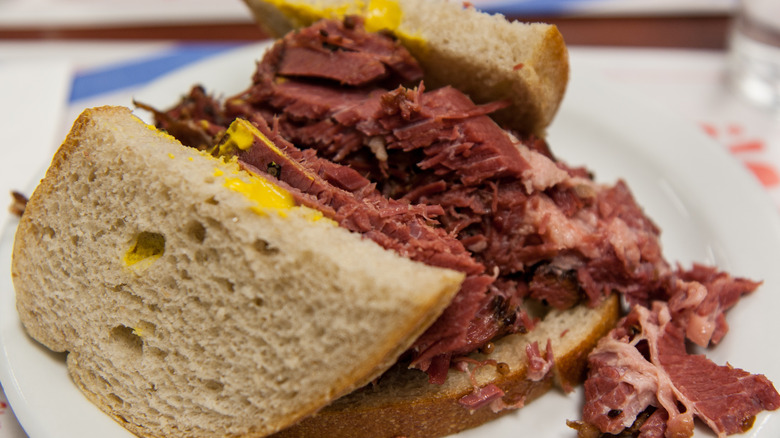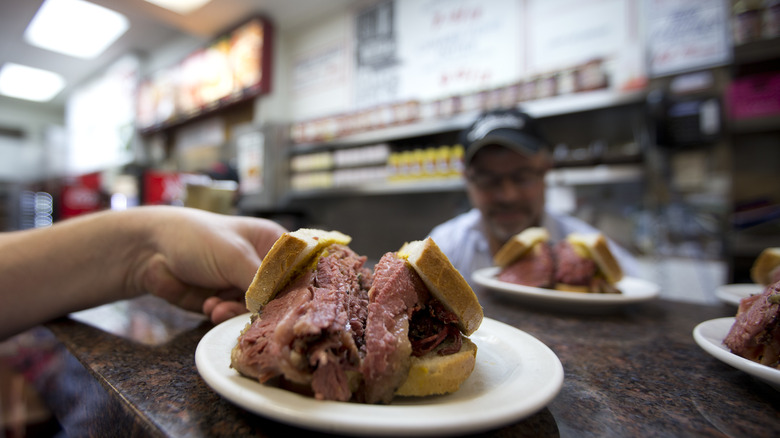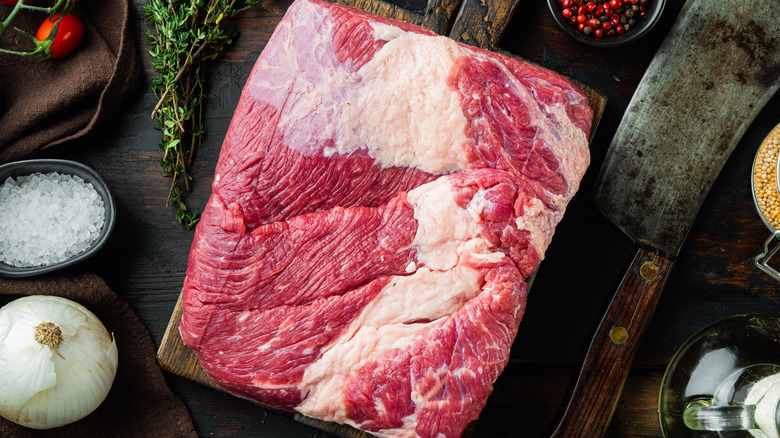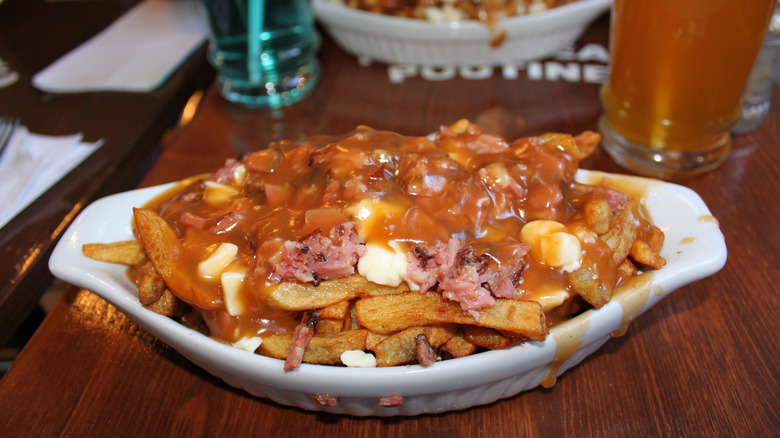Montreal Smoked Meat Bridges The Gap Between Corned Beef And Pastrami
With its cold and snowy winters, Canada's province of Quebec has developed an appetite for hearty and filling meals, often with meat at the center. The same is true for its largest city, Montreal, whose name is on many labels of steak seasoning. Montreal Steak Seasoning was inspired by the spices used on the city's famous smoked meat, according to the CBC. Many delis and restaurants selling smoked meat (viande fumée in French) have built their reputation on their decades-long recipes.
Creating Montreal smoked meat takes patience, time, and attention to detail, but most who have tasted the meat would say it's well worth it. Food Network describes Montreal smoked meat as "succulent," "smoky," and "savory." Per Glebe Kitchen, part of that succulent taste comes from the fact that the brisket used to make it keeps the fat intact. The famous spice blend used to make Montreal smoked meat also gives it a more subtle and complex flavor than other similar dishes, per Serious Eats. No matter how you describe the taste, it's clear that Montreal residents love their smoked meat.
The smoky history of Montreal smoked meat
Montreal smoked meat traces its origin back to Eastern European Jewish immigrants who settled in the large French Canadian city, per Food & Wine. While similar to and influenced by corned beef and pastrami, viande fumée's origin is totally French Canadian. Eater Montreal reports that there has been debate for years over who the first person was to make Montreal smoked meat. This uncertainty led Eiran Harris, the archivist emeritus of the Jewish Public Library, to dig deep for answers. Harris told Érudit in 2009 that Aaron Sanft of Yassi, Romania — who came to Montreal in 1884 — was the man behind the smoked meat. It's not known what year he first began to sell it.
In the years since Sanft started to sell Montreal smoked meat, others began to excel at making it as well. Those others included Benjamin Kravitz, founder of Bens De Luxe Delicatessen, and Reuben Schwartz, founder of Schwartz's Hebrew Delicatessen (via Food Network). These two restaurants both became famous for their meats. Bens De Luxe Delicatessen opened in 1908 (and closed in 2006), followed by Schwartz's Hebrew Delicatessen in 1928. Other delis have since opened to serve viande fumée, winning over sandwich fans in the process.
How Montreal smoked meat is made
Want some Montreal smoked meat, but live nowhere close to the Canadian city? Don't fret. You don't need an airplane ticket to enjoy the savory dish. For instance, Glebe Kitchen shares a recipe that lists beef brisket, cracked black peppercorns, coriander seed, cloves, and bay leaves, among the ingredients.
To transform your 12-to-14-pound brisket into Montreal smoked meat, time, a smoker, and a steamer are needed. The steps include curing the meat for eight days in the refrigerator, during which time it needs to be turned twice a day. During the eighth day, the brisket must be soaked in cool water for 30 minutes at a time, before having the container drained and refilled, according to Glebe Kitchen. The process needs to be repeated during a six-hour time period, and then the meat is dried, coated with the rub, and refrigerated. Finally, on the ninth day, the brisket is ready to be smoked for eight to nine hours, before once again being placed in the refrigerator.
Even after all of this time, the meat still needs to go through one more step –- steaming. Glebe Kitchen says the brisket should be steamed for about three hours before being cooled to a safe handling temperature in order to be sliced and enjoyed.
Differences from pastrami and corned beef
While similar to both pastrami and corned beef, Montreal smoked meat is unique in the process in which it is made, as well as in its taste. Both corned beef and Montreal smoked meat are made from brisket, according to Food & Wine, but viande fumée doesn't have a spice coating like the one used for corned beef. A similarity that the famous Canadian dish has to pastrami is that they're both smoked. However, the time spent in the smoker for viande fumée is longer. To make all three, the meat is brined, but the key difference is that the brine for Montreal smoked meat has very little or no sugar at all (per Food & Wine).
One of the biggest differences between pastrami and Montreal smoked meat, according to Serious Eats, is that the whole brisket is smoked for viande fumée, which gives customers the option of eating a fattier or leaner cut. In contrast, pastrami is generally made from the brisket flat or beef plate. It's the last step of making Montreal smoked meat — steaming — that really takes the flavor to the next level, and the meat's texture is smoother than pastrami after being steamed. Due to its smoking and steaming process, Montreal smoked meat can be eaten cold, hot, or steamed (via Food & Wine).
Where and how Montreal smoked meat is served
Serving Montreal smoked meat for more than 90 years, Schwartz's Hebrew Delicatessen is believed to be Canada's oldest active deli, according to Food Network. On its menu, Montreal smoked meat is served as a sandwich and as a small or large plate. A number of other delis have become known for their smoked meats, such as Lester's Deli and Reuben's Deli & Steakhouse. The Lester's website says that they've been selling smoked meat for over 60 years, while Reuben's is known for its 10-ounce smoked meat sandwich served on rye bread with mustard. For those with an even larger appetite, the Big Bang Sandwich contains a pound of smoked meat.
Jarry Smoked Meat has gotten more creative with its application of viande fumée, serving it with poutine and even on pizza. Of course, it's also still sold in the more traditional sandwich form.




